Tourism refers to the act of travelling for recreational, business, and leisure purpose. People all over the world are travelling to different destinations. Travelling has become an important part of human life, and the tourism industry has faced increasing challenges and pressure with the increasing demand of travelling. According to (Onyangu & Kaseje, 2015), nowadays, it has become increasingly important to manage sustainable tourism development. For this, it is essential to consider the growing environmental problems. (Blackman, Foster, Hyvonen, Jewell, Kuilboer, & Moscardo, 2015) stated that tourism development is planned and implemented with the aim of stimulating the regional economic development in the developing countries. In the past, the tourism development planning was considered as a private sector activity that intended to meet the growing demands of the dynamic industry. After the Second World War, the tourism industry turned into a mainstream industry. The World Trade Organisation has claimed that tourism is one the main drivers for socio-economic progress and development. Tourism has significantly influenced different destinations and places around the world. However, many scenarios suggest the adverse impact of tourism on the environment and communities. To deal with the negative impact, it is necessary to plan tourism according to the philosophies of sustainability.
Get Help With Your Essay
If you need assistance with writing your essay, our professional essay writing service is here to help!
The report tends to analyse the concept of Tourism Sustainability and how it challenges the conventional ways of designing strategies for a national tourism plan. The findings are based on examining the tourism development programmes and its implementation in developing and developed countries. (Zamfir & Corbos, 2015) claimed that economically, the tourism planning is far-sighted and it involves considering different sectors in order to trigger the development effectively and efficiently. The report focuses on comparing the sustainable tourism with conventional tourism planning. In the end, recommendations are included for future development planning and development concept.
(Liu & Mwanza, 2014) indicated that the concept of sustainable development had been widely accepted by different countries and regions to carry put their planning and development functions and processes. It is based on the concept of creating a better future by ensuring that the present is not compromised. Sustainable development aims to safeguard and protect the earth’s capability to support life. It is mainly concerned about the social equity, cultural diversity, environmental protection, and developing a viable economy. As claimed by (Singh, 2015) sustainable tourism aims to meet the ecological, culture, economic, and social requirements of a country. It is based on focusing on the long-term aspects of tourism by ensuring that the present and future demands are met effectively and ethically. The term sustainability focuses on the long-term and future-oriented requirements, which must be fulfilled by taking considerable actions and decisions. (Moscardo, 2013) stated that the primary objective of sustainable tourism development is to focus on different areas of sustainable development in tourism. The concept of sustainable tourism is applicable to all the types of destinations and all forms of tourism. Taking the example of tourist education guide programs sustainable tourism planning can be understood in a better manner. These programs aim to educate the tourists about the natural environment and resources so that they value it preservation.
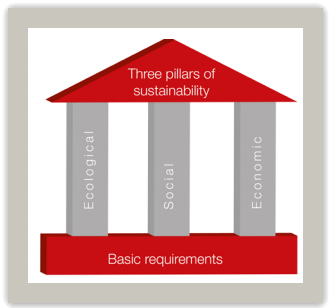
Table 1: Pillars of Sustainability
(Onyangu & Kaseje, 2015)
(Liu & Francis, 2013) stated that the sustainable development focuses on meeting the current needs without compromising the future needs of the nation. Sustainable tourism development is based on the concept of creating a balance between the cultural, economic, and social aspects of the nation. It ensures that none of the activities will lead to endangering of the animals or environment. The process of sustainable development focuses on promoting development without depletion of resources and is accomplished by effectively managing the resources. Basically, the concept of sustainable development is based on certain principles, which focuses on ensuring that the development is compatible with the maintenance of biological resources and ecological processes. The sustainable tourism should be planned in a cost effective manner so that the resources are managed and utilised effectively (Blackman, Foster, Hyvonen, Jewell, Kuilboer, & Moscardo, 2015).
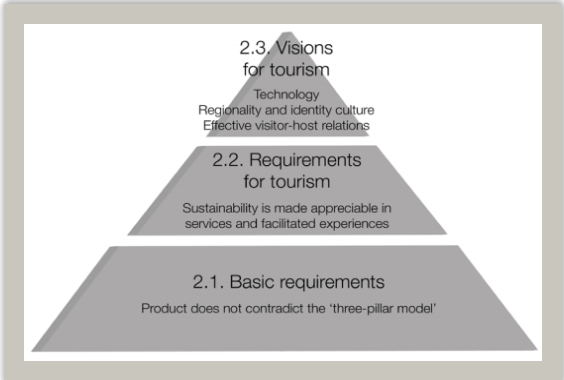
Table 2: Sustainability Pyramid in Tourism
(Moscardo, 2013)
(Dangi & Jamal, 2016) reported that sustainable development is considered as one of the best solutions to social degradation and other environment problems. The concept of sustainable tourism development includes different dimensions that relate the culture, economic, social, and environmental development with each other. The sustainable development planning mainly focuses on the preservation of environmental resources, and the activities are planned in such a manner that the intensive and excessive use of resources is avoided. (Tourism, 2016) claimed that Green Globe is one of the sustainable tourism initiatives taken by the tourism operators in New Zealand. It promotes sustainable travel and tourism across the triple bottom line. The Sustainable Business Company is responsible for monitoring and assisting the tourism operators in the country so that they can facilitate the growth of sustainable tourism development programs.
As stated by (Vlaicu, 2010), the international donor agencies and government were responsible for promoting the tourism development planning in developing nations. The conventional tourism planning is based on the concept of making a huge profit by satisfying the tourists. It is a tourist-oriented development planning and has facilitated many countries in enhancing their tourism sector. The convention planning gives priority to economic benefits. The advancement in Information and Technology has facilitated the convention tourism industry. With the passage of time, the importance of conventional tourism has rapidly enhanced as it has a relevant impact on the environment, economy, and population of the chosen place. To promote conventional tourism and achieve success through it, it is important to plan and implement effective strategies (Larsen, 2016).
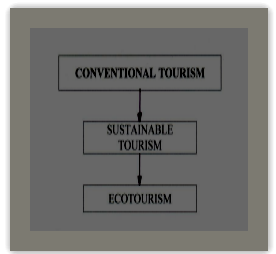
Table 3: Conventional Tourism to Sustainable Tourism
(Larsen, 2016)
(Dredge & Jamal, 2015) claimed that the conventional tourism planning policies focus on attracting tourists from all over the world. It emphasizes on entertaining and satisfying the tourists, without considering the impact on natural resources and environment. The businesses in New Zealand are using various traditional marketing approaches to promote tourism in the country. For example, the destination management processes are being implemented in the country. The concept is based on the promotion of different elements of the destination, which include infrastructure, people, values and culture. The place is marketed to attract tourist and encourage different types of site management activities. In New Zealand, the tourism industry has undergone various changes and developments. The businesses aim to provide tourists with a chance to enjoy the mountains, forests, islands, wetland, and high country. The economic value is the main concern while making the country sites suitable, accessible, and family-friendly (Yeoman, Andrade, Leguma, Wolf, Tan, & Beattie, 2015).
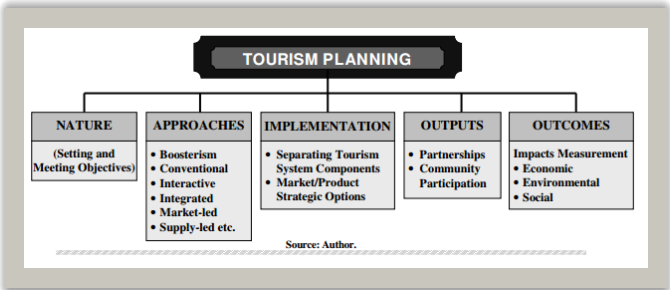
Table 4: Tourism Planning
(Najdeska & Rakicevik, 2012)
According to (Najdeska & Rakicevik, 2012), the growth in the tourism industry has positively and negatively affected different aspects of the societies and communities. Sustainable development focuses on the planning and development without the exploitation of the natural resources or affecting the cultural aspects of the societies. It aims to preserve the culture and nature for the future generations. (Hassan & Bayazidpour, 2016) claimed that planning of sustainable tourism is dependent on preserving the environment and making decisions that lead to positive development. The sustainable tourism faces different types of challenges at a different level, which include making tourism accessible to all, preserving the natural and cultural resources, reducing the seasonality of demand, and promoting the well-being of the local societies and communities.
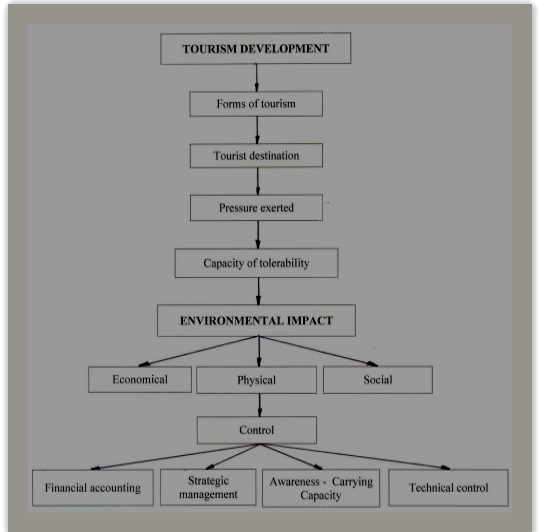
Table 5: Tourism Development Plan
(Singh, 2015)
The comparison of conventional and sustainable tourism has helped in realising that conventional tourism is not necessarily planned to consider the enhancement of education or conservation. It does not aim to enhance the local community, if the goals are targets of conventional development plan are not effectively managed, it can result in damaging the fragile environment. The culture and resources are also under the threat of being destroyed or altered as a result of conventional tourism. (Dangi & Jamal, 2016) claimed that in the past, many conventional tourism practices posed a threat to the conservation. It was due to lack of control, management, and ineffective planning techniques.
Find Out How UKEssays.com Can Help You!
Our academic experts are ready and waiting to assist with any writing project you may have. From simple essay plans, through to full dissertations, you can guarantee we have a service perfectly matched to your needs.
View our academic writing services
In contrast, the sustainable tourism is planned with the aim of benefiting the local residents, protecting the culture, and conserving the natural resources. The plan involves educating both the local residents and tourists. (Hassan & Bayazidpour, 2016) stated that the benefits of sustainable tourism are similar to conventional tourism. In addition, it not only protects the culture and natural resources but also focuses on the well-being of the community and society both economically and socially. The conventional planning only focuses on profits, while sustainable tourism is based on enhancing the environment and community and achieving profits. The conventional tourism is tourist-oriented while sustainable tourism is locally-oriented. Conventional emphasises on creating entertainment for the tourists, while sustainable tourism provides learning experience where conservation of the natural resources is termed as a priority. It is believed that the tourism planning is dependent on the goals and objectives set by the government and tourism industry. There are certain policies and regulations that must be followed throughout the planning and implementation process (Vlaicu, 2010).
The tourism industry is growing and developing continuously with the passage of time. To achieve sustainable tourism development, it is important to focus on following the principles of sustainable tourism (Moscardo, 2013). As the level of challenges and complexities have increased, it is recommended to follow the following principles to attain the goal of development:
- Plan for long-term goals and objectives
- Set and respect the limits of environment and society
- Monitor the changes and developments continuously
- Take an integrated or holistic approach to development
- Choose an adequate pace of development
- Take cost-effective methods and approaches
- Involve the stakeholders in the process of development
- Examine and manage risk by implementing risk mitigation strategies
In this competitive era, the economic development of the countries is dependent on it tourism sector up to a great extent. Considering this fact, the government of the developing countries is supporting the tourism sector by making effective policies and standards regarding tourists. It is highly recommended that the nations focus on the growing and changing needs and demands of the tourists belonging to different backgrounds. The hospitality industry should focus on developing highly attracting services and places to attract tourists from different regions and countries. The implementation of sustainable tourism policies and development framework will help in achieving sustainability and protecting the natural resources and environment of the country.
 Analysing and examining the concept of tourism sustainability, it has been seen that the strategic objective of sustainable development planning can only be achieved when all the four elements of the nation are given equal importance. These elements include economic, cultural, environmental and social aspects of the nation that are interconnected with each other. The sustainable tourism promotes responsible tourism where the tourists enjoy and appreciate nature and ensure that their activities do not harm the natural environment or resources in any manner. It promotes conservation and is appreciated and accepted all over the world by the tourist sector. With the advancement in the tourism industry, both conventional and sustainable tourism development planning has gained a lot of attention.
The Government and businesses operating in the industry are developing tourism plans to enhance the environment and gain social and economic benefits. Conventional tourism focuses on profitability while sustainable tourism is more concerned about the conservation of the natural environment and resources. In New Zealand, the number of tourists has commendably increased in the past few years. The country has introduced attractive policies and development programs to facilitate the tourists belonging to different age groups and backgrounds. To achieve economic and environmental benefits, the country is undergoing various changes and developments with the passage of time. These developments are promoted by the sustainable and conventional tourism planning approaches and techniques.
References
Blackman, A., Foster, F., Hyvonen, T., Jewell, B., Kuilboer, A., & Moscardo, G. (2015). Factors contributing to successful tourism development in Peripheral Regions. The Journal of Tourism Studies , 15 (1), 59-65.
Dangi, T., & Jamal, T. (2016). An integrated approach to sustainable community-based tourism. Sustainability , 8 (2), 1-32.
Dredge, D., & Jamal, T. (2015). Progress in tourism planning and policy: A post-structural perspective on knowledge production. Tourism Management , 51 (2), 285-297.
Hassan, A., & Bayazidpour, H. (2016). Analysis and sustainable tourism development planning in the Kurdistan Province. International Academic Journal of Humanities , 3 (6), 1-16.
Larsen, G. (2016). The unappreciated slowness of conventional tourism. A Multidisciplinary e-Journal , 27 (2), 35-52.
Liu, B., & Mwanza, F. (2014). Towards sustainable tourism development in Zambia: advancing tourism planning and natural resource management . Journal of Service Science and Management , 7 (2), 30-45.
Liu, Z., & Francis, A. (2013). Sustainable tourism development: a critique. Journal of Sustainable Tourism , 11 (6), 459-475.
Moscardo, G. (2013). Interpretation and sustainable tourism: functions, examples, and principles. The Journal of Tourism Studies , 14 (1), 112-121.
Najdeska, K., & Rakicevik, G. (2012). Planning of sustainable tourism development. Procedia Social and Behavioral Sciences , 44 (2), 210-220.
Onyangu, J., & Kaseje, M. (2015). Tourism planninga and developemnt for sustainability. American Journal of Economics, Finance and Management , 1 (5), 336-345.
Singh, V. (2015). Eco-tourism as a sustainable alternative to conventional tourism. Tourism and Hospitality , 4 (4), 1-10.
Tourism, N. (2016). New Zealand Tousim Guide. Retrieved February 20, 2017, from Tourism in New Zealand: http://www.tourism.net.nz/community/environmental-sustainability
Vlaicu, A. (2010). Conventional tourism from sustainable tourism to ecotourism . Conventional Tourism Journal , 5 (1), 43-49.
Yeoman, I., Andrade, A., Leguma, E., Wolf, N., Tan, R., & Beattie, U. (2015). 2050: New Zealand’s sustainable future. Journal of Tourism Futures , 1 (2), 117-125.
Zamfir, A., & Corbos, R. (2015). Towards sustainable tourism development in urban areas. Sustainability , 7 (1), 12709-12722.
Cite This Work
To export a reference to this article please select a referencing style below:


